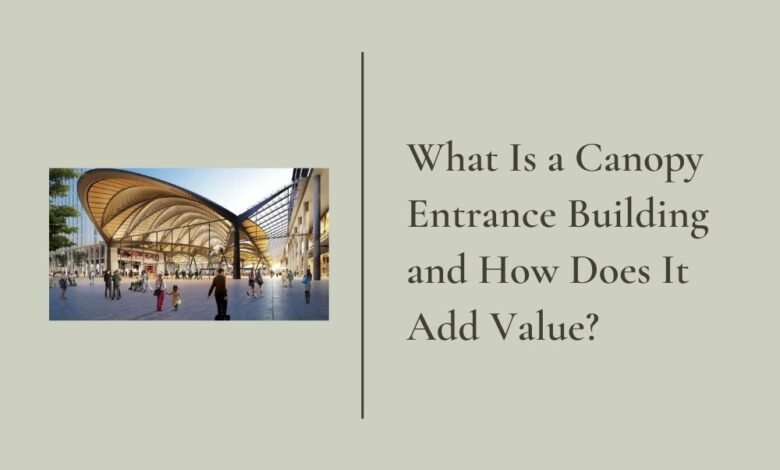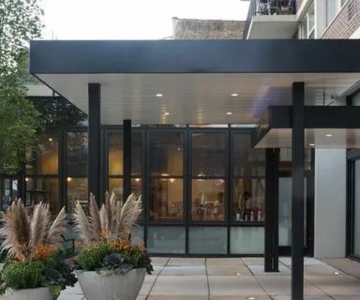
A canopy entrance building, often just called a canopy entrance, is an architectural feature that serves both functional and aesthetic purposes in buildings ranging from commercial establishments to residential complexes. These structures are designed to provide shelter from weather elements at the entrance of a building and significantly enhance the building’s visual appeal. In this blog, we’ll explore what exactly a canopy entrance building is, the different types available, and how they can add value to a property.
Understanding Canopy Entrances
Definition of a Canopy Entrance
A canopy entrance refers to a covered structure that is attached to the entrance of a building. It extends out from the building’s facade, providing a roofed shelter that protects people entering or leaving the building. Canopy entrances are made from various materials including glass, metal, fabric, or polycarbonate, depending on the architectural requirements and design aesthetics.
Types of Canopy Entrances
Glass Canopies
Glass canopies are popular due to their modern look and the ability to let natural light filter through. They are often used in commercial buildings like shopping centers, offices, and hotels to create an inviting and open entrance space.
Metal Canopies
Metal canopies, typically made from steel or aluminum, are known for their durability and high strength-to-weight ratio. They are versatile in terms of design and are often used in both industrial and educational buildings for their practicality and longevity.
Fabric Canopies
Fabric canopies provide a soft, elegant look and are frequently used in residential properties and outdoor venues like cafes and restaurants. They add a colorful and light aesthetic while still offering protection from the sun and rain.
How Canopy Entrances Add Value to Buildings
Enhancing Curb Appeal
First Impressions Matter
One of the primary ways a canopy entrance adds value is by enhancing the building’s curb appeal. A well-designed canopy can transform the appearance of a building, making it more attractive and inviting. This is particularly important for commercial properties, where a good first impression can attract more customers.
Architectural Accent
Canopies serve as an architectural accent, adding character and style to a building’s facade. Whether it’s a sleek glass structure or an ornate metal design, a canopy can be a striking addition that complements the building’s architecture.
Providing Functional Benefits
Weather Protection
Canopy entrances provide essential protection against the elements, shielding people from rain, snow, and sun as they enter or exit a building. This makes entering the building more comfortable and can prevent water and debris from being tracked inside, reducing maintenance costs.
Energy Efficiency
By shading the entrance area, canopies can also reduce the amount of heat that enters a building, particularly if made from materials like metal or fabric with reflective properties. This can help lower cooling costs during warm months, adding an element of energy efficiency to the building.
Improving Safety
Safe Entry and Exit
Canopies contribute to safety by reducing the risk of slipping outside the entrance due to rain or snow. They also help ensure that the entryway is well-lit at night, improving visibility and security for both employees and visitors.
Increasing Property Value
Attractiveness to Tenants or Buyers
For property owners, installing a canopy entrance can increase the building’s marketability and potentially its overall value. Aesthetic improvements and functional benefits like enhanced safety and reduced energy costs make the property more attractive to prospective tenants or buyers.
Offering Customization and Branding Opportunities
Tailored Designs
Canopies can be customized to suit specific branding requirements, which is particularly valuable for businesses. A canopy can be designed to reflect a company’s logo, color scheme, and overall brand identity, reinforcing brand presence in a physical location.
Selecting the Right Canopy for Your Building

Consider the Building’s Architecture
The style of the canopy should complement the overall architecture of the building. An ultra-modern glass canopy might suit a new office building but could look out of place on a more traditional or historic property.
Assess the Climate
The choice of material for a canopy should also consider the local climate. In areas with heavy snowfall, a sturdy metal canopy might be more appropriate than a fabric one, which could sag under the weight of the snow.
Work with Professionals
To ensure the best results, it’s advisable to work with professional designers and installers who specialize in canopy construction. They can provide valuable insights into the best materials and designs for your specific needs and ensure that the installation is safe and compliant with local building codes.
Conclusion
A canopy entrance is not just a decorative addition to a building but a multifunctional feature that enhances both the aesthetic appeal and functionality of a property. By improving curb appeal, offering weather protection, and providing safety benefits, canopy entrances add significant value to any building. Whether you are looking to upgrade a commercial property or enhance a residential building, a professionally installed canopy entrance can make a substantial difference.
Note:- For read more articles visit on toastul.


